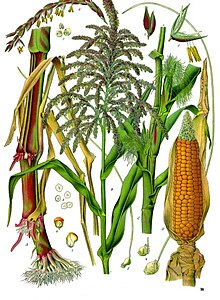**1. Historical Development of Maize:**
– Maize originated from a single domestication in southern Mexico around 9,000 years ago.
– Oldest maize types were found in the Mexican highlands.
– Maize spread through Mesoamerica via two major paths.
– Olmec and Maya cultures cultivated various maize varieties.
– Maize was central to Olmec culture 3,000 years ago.
– Maize domestication likely began in the Balsas River valley of Mexico.
– Maize reached Ecuador, Central America, and the Colombian Andes early on.
– Mapuche people in Chile cultivated maize with quinoa and potatoes.
**2. Spread and Cultural Impact of Maize:**
– Spanish settlers introduced maize to Europe post-1492.
– Maize cultivation spread globally due to its adaptability to diverse climates.
– Maize became a staple food in Southern Europe by the 17th century.
– Maize introduction initially led to malnutrition issues until nixtamalization.
– Nixtamalization process liberated essential niacin in maize.
– Maize has been a staple food for indigenous cultures.
– Maize is used in traditional ceremonies and rituals.
– Maize is a symbol of sustenance and life in many cultures.
– Maize plays a significant role in art, literature, and folklore.
**3. Botanical Characteristics and Genetics of Maize:**
– Maize is a tall annual grass with a single stem.
– Maize is a monoecious plant with male and female flowers.
– Maize ears produce grain kernels or seeds.
– Maize is diploid with 20 chromosomes.
– 83% of allelic variation in maize is from teosinte ancestors.
– Exotic varieties add genetic diversity in breeding.
– Maize is a model organism for genetics and developmental biology.
**4. Cultivation Challenges and Economic Importance:**
– Maize shoots produce antibiotic substance DIMBOA.
– Shallow roots make maize susceptible to drought.
– Maize is intolerant of nutrient-deficient soils.
– Severe winds can uproot maize plants.
– Tropical cultivars may face challenges in higher latitudes.
– Maize is used for food, feed, biofuels, and industrial products.
– Maize genome sequencing was completed in 2008.
– The International Maize and Wheat Improvement Center maintains a maize collection.
– Maize is a staple crop in many countries, supporting economies.
**5. Terminology and Global Usage of Maize:**
– The name ‘maize’ comes from the Spanish ‘maíz’ of the Taíno ‘mahis.’
– ‘Maize’ is preferred in scientific usage over ‘corn.’
– ‘Corn’ is primarily used in the United States and a few other English-speaking countries.
– ‘Corn’ for maize originated as a shortening of ‘Indian corn’ in 18th-century North America.
– International organizations favor the term ‘maize’ over ‘corn.’
Maize /meɪz/ (Zea mays), also known as corn in North American and Australian English, is a tall stout grass that produces cereal grain. It was domesticated by indigenous peoples in southern Mexico about 9,000 years ago from wild teosinte. Native Americans planted it alongside beans and squashes in the Three Sisters polyculture. The leafy stalk of the plant gives rise to male inflorescences or tassels which produce pollen, and female inflorescences called ears which yield grain, known as kernels or seeds. In modern commercial varieties, these are usually yellow or white; other varieties can be of many colors.
| Maize | |
|---|---|

| |
| Includes male and female flowers | |
| Scientific classification | |
| Kingdom: | Plantae |
| Clade: | Tracheophytes |
| Clade: | Angiosperms |
| Clade: | Monocots |
| Clade: | Commelinids |
| Order: | Poales |
| Family: | Poaceae |
| Subfamily: | Panicoideae |
| Genus: | Zea |
| Species: | Z. mays
|
| Binomial name | |
| Zea mays | |
Maize relies on humans for its propagation. Since the Columbian exchange, it has become a staple food in many parts of the world, with the total production of maize surpassing that of wheat and rice. Much maize is used for animal feed, whether as grain or as the whole plant, which can either be baled or made into the more palatable silage. Sugar-rich varieties called sweet corn are grown for human consumption, while field corn varieties are used for animal feed, for uses such as cornmeal or masa, corn starch, corn syrup, pressing into corn oil, alcoholic beverages like bourbon whiskey, and as chemical feedstocks including ethanol and other biofuels.
Maize is cultivated throughout the world; a greater weight of maize is produced each year than any other grain. In 2020, world production was 1.1 billion tonnes. It is afflicted by many pests and diseases; two major insect pests, European corn borer and corn rootworms, have each caused annual losses of a billion dollars in the US. Modern plant breeding has greatly increased output and qualities such as nutrition, drought, and tolerance of pests and diseases. Much maize is now genetically modified.
As a food, maize is used to make a wide variety of dishes including Mexican tortillas and tamales, Italian polenta, and American hominy grits. Maize protein is low in some essential amino acids, and the niacin it contains only becomes available if freed by alkali treatment. In Mesoamerica, maize is personified as a maize god and depicted in sculptures.

